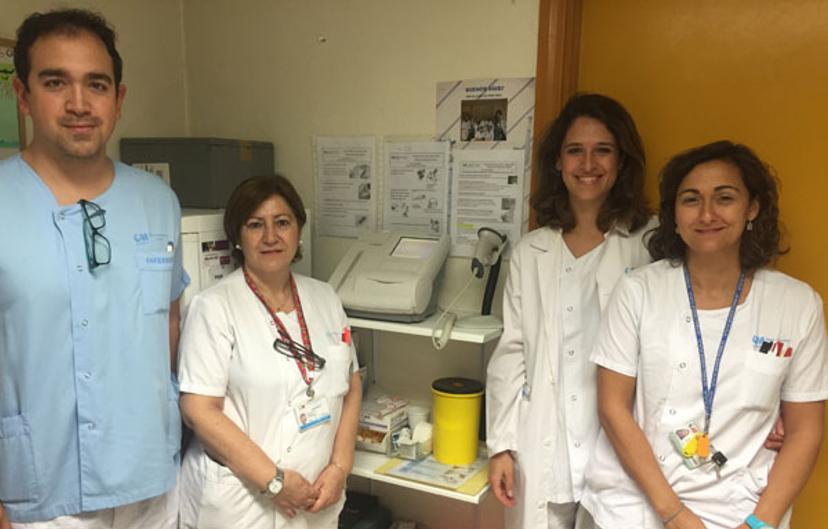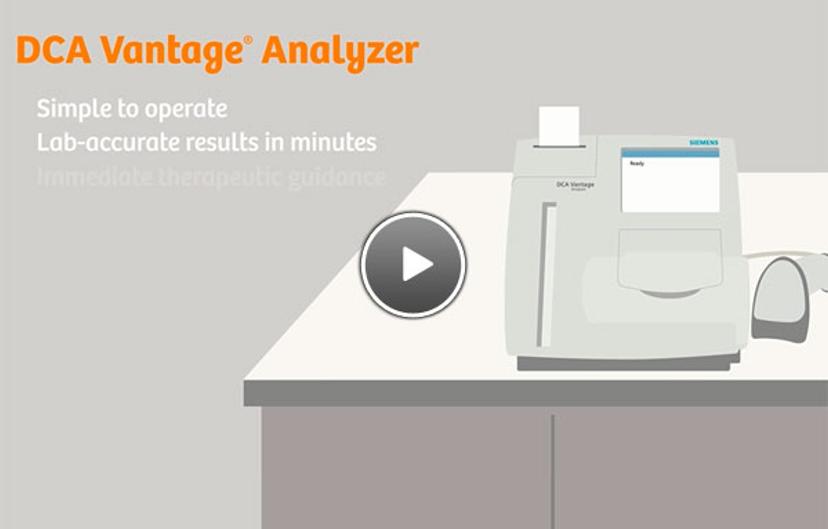Leading the Field in Diabetes Point-of-Care Testing at the La Paz University Hospital, Spain
Find out how the Department of Laboratory Medicine at La Paz University Hospital is utilizing the Siemens DCA Vantage to improve diabetes monitoring and patient care
22 Nov 2017


Paloma Oliver, Faculty Area Specialist in Clinical Analysis and POCT Coordinator, La Paz University Hospital, Spain
Point-of-care testing (POCT) continues to be a rapidly evolving and increasingly important field of interest in clinical diagnostics. The La Paz University Hospital, Spain, serves over 500,000 people, and operates an industry-leading point-of-care service. SelectScience® speaks to Paloma Oliver, Faculty Area Specialist in Clinical Analysis and POCT Coordinator, to find out more.
SS: Please briefly introduce yourself and your place of work.
I have a Pharmacy Degree from the Complutense University and a PhD in Medicine Faculty from the Autonoma University, both in Madrid, Spain. I am also a specialist in Clinical Pathology and the Point-of-Care Coordinator in the Department of Laboratory Medicine in La Paz University Hospital in Madrid.
In La Paz University Hospital, the Department of Laboratory Medicine started to take part in POCT in 1998, with blood gases. Dr. Felícitas Mateos, Dr. Antonio Buño and Dr. Teresa Contreras developed this field, creating the POCT Committee as a multidisciplinary group. This Committee includes professionals from different areas such as the clinical laboratory, members of the hospital administration, physicians from medical and surgical services, representatives of nursing personnel and staff from the IT department. The POCT project has always been supported by the hospital Board of Directors. I should also mention the role IVD companies have played during these years.
Currently, the Point-of-Care Testing Unit is part of the Department of Laboratory Medicine. Dr. Antonio Buño is the POCT Director and I am the POCT Coordinator. This Unit is included in the Quality Section of which Dr. Pilar Fernandez-Calle is the head. The Emergency Laboratory also actively collaborates by continuously monitoring all POCT analyzers.
At the moment, our POCT network includes 28 blood gas analyzers, 2 HbA1C devices and 5 glucometers, all accredited by ISO 22870. The POCT Unit also coordinates the other 261 glucometers located in different clinical settings throughout the hospital.

Additionally, since 2012 I am the President of the Point-of-Care Testing Commission of the Spanish Society of Medicine Laboratory (SEQCML). During these years, the Commission has published documents, surveys and other publications, we have organized courses and symposia and we have participated in research projects concerning POCT. All of this has been done in collaboration with other Commissions of SEQCML and other scientific societies such as the Spanish Diabetes Society.
SS: What projects are you currently working on?
In La Paz University Hospital, we are dealing with numerous issues. These include daily analyzer monitoring, method evaluation, connectivity, calibration, quality assurance, reporting of results, personnel training, preventive and corrective maintenance, etc. The POCT Committee is also essential to the organization and management of projects.
Another thing to note is that before the installation of an analyzer in any clinical setting, we evaluate the current activity of the clinical department. This includes the type of patients, the clinical needs, the aspects that could be improved by POCT, etc. If the incorporation of POCT is approved, we evaluate the impact of the activity after the installation because we consider this to be very relevant. At the moment, we are evaluating the clinical, operative and economic outcomes of a POCT blood gas analyzer located in the Nephrology Department. This is similar to other studies that we have previously performed in other clinical settings such as in the Pulmonary Office.
Regarding our evaluation of the interchangeability of patient results and other method evaluations, we follow a specific procedure according to CLSI protocols. This is done before the installation of every device in a clinical setting. In addition to this, we also consider the monitoring of this evaluation after the installation in routine practice to be important. Although the first study showed the interchangeability of the results, these could be different in clinical practice. This could be due to mainly preanalytical factors such as patient preparation, sample collection, etc. This evaluation is relevant because of the possible impact on patient care.
…the comparison of the DCA Vantage and the central laboratory method showed that HbA1C results were interchangeable. This is essential because patient samples can be measured in the laboratory, or as POCT, depending on the clinical management. That way, if we find differences, these must then be due to a change in the patient’s clinical condition and not analytical differences between methods.
Paloma Oliver La Paz University Hospital
Other projects that we have carried out have been related to patient safety issues. These include patient ID errors or bacterial contamination of glucose test strips. We also monitor some indicators as a tool of continuous improvement such as adequacy of POCT test requests and evaluation of operators training and competency.
In the POCT Commission of SEQCML, one of the recent activities has been the creation of documents relating to analytical quality specifications of glucometers, in collaboration with the Spanish Diabetes Society. We have also created a database of POCT devices entitled “POCT ONLINE” with more than 300 magnitudes (http://www.seqc.es/es/comisiones/comision-de-pruebas-de-laboratorio-en-el-lugar-de-asistencia-poct/_id:22/). The aim of this project is to provide the user with comprehensive information that help them to select the most appropriate analyzer to meets their needs.
SS: Which Siemens Healthineers technologies and methods do you use, and why?
There are two Diabetes Units in La Paz University Hospital. One is for adults and the other is for pediatric patients. There is a Siemens DCA Vantage in each clinical setting for HbA1C measurements. This device is considered appropriate for our diabetic patients because of the following considerations:
Firstly, the comparison of the DCA Vantage and the central laboratory method showed that HbA1C results were interchangeable. This is essential because patient samples can be measured in the laboratory, or as POCT depending on the clinical management. That way, if we find differences, these must then be due to a change in the patient’s clinical condition and not analytical differences between methods.
On the other hand, the analytical specifications established by laboratory (POCT Unit) are based on clinical use and ADA recommendations. We monitor quality assurance on a monthly basis according to this criteria. The DCA Vantage has met analytical performance goals in both internal and external quality control monitoring.

The Siemens DCA Vantage also offers other advantages such as connectivity to laboratory information systems, it meets NGPS performance criteria, it is easy to use and maintain, it reduces the turnaround time simplifying diabetes testing workflow, etc. All of these factors are useful in the physician’s office and for the remote control from the laboratory.
SS: What new trends are you seeing in the field of diabetes diagnosis and/or management?
Globally, POCT technology continues to develop. Smaller and easier to use devices are being designed with an improved analytical performance, so they are useful in other clinical scenarios such as diagnosis, narrowing the gap with traditional laboratory methods. In diabetes, the availability of accurate methods with short turnaround times is crucial for an early diagnosis and reducing complications as a consequence.
As a chronic disease, diabetic patients need to frequently measure some magnitudes and because of this, use of continuous monitoring systems or noninvasive analysis is growing. For instance, the development of new technologies that use continuous glucose monitoring technology integrated with insulin pumps, has the potential to significantly improve glycemic control.
At the same time, the devices that provide other magnitudes of measurements, such as simultaneous renal or cardiovascular biomarkers, are also interesting.
There are other clinical scenarios such as critical care units or neonatal intensive care units where glucose monitoring is essential for an early detection of hyper- and hypoglycemia.
SS: What is the future for your work, and its potential impact on patient care?
In our experience, the involvement of the clinical laboratory with POCT in diabetic patient care is crucial, with the collaboration of other professionals and also the patients. A correct initial evaluation of the appropriateness of POCT in every clinical setting must be carried out adequately before the installation of any device, considering activity in the previous time, type of patients, clinical use of every magnitude, technical aspects and also the clinical, operative and economic outcomes after implementing POCT.
Additionally, after a period of time, the impact of the use of POCT in the clinical setting should be assessed before and after the installation, in order to know its real influence and other actions that must be carried out to improve patient care.
The creation of a homogenous POCT network for all clinical settings with diabetic patients (primary, secondary and tertiary care), always lead by the clinical laboratory, with interchangeability of results, connectivity for all routine analyzers monitoring, quality assurance, involvement of results in medical records or management indicators is relevant to help us to improve the management of POCT and consequently, improve patient care.
Download Case Study: A Pioneering Approach to Diabetes Treatment
Download Infographic: What is Diabetes?
Get more great content like this sent to your inbox: Register as a SelectScience member today

